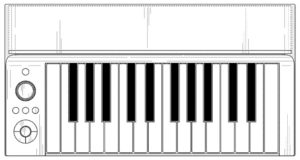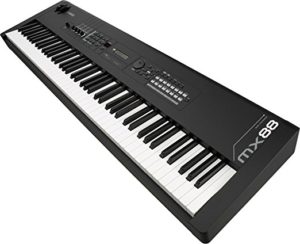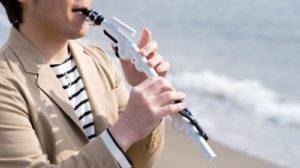Raining like crazy today, so it’s a good chance to look for new patents and patent applications.
First, here are a few new technical patents assigned to Yamaha. US Patent 9,536,508 titled “Accompaniment data generating apparatus,” awarded on January 3, 2017, describes accompaniment generation using a combination of MIDI and audio waveforms. The accompaniment generator follows chord changes, etc. just like today’s arrangers except that it also plays back melodic (pitched) audio phrases as well as MIDI. This is very likely the nexus of the next generation of Yamaha arrangers (flagship “GENOS“).
US Patent 9,514,728 titled “Musical performance apparatus that emits musical performance tones and control tones for controlling an apparatus,” awarded December 6, 2016, describes a system for near ultrasonic communication between a tablet and a keyboard. Software on the tablet controls tone generation on the keyboard, allowing an app to play back a musical performance (e.g., MIDI over near ultra sonic sound). I suspect that some future Yamaha patent will use this technology for wireless tablet to keyboard communication in place of Bluetooth or WiFi.
The third patent, number 9,489,938 is titled “Sound synthesis method and sound synthesis apparatus” and was awarded on November 8, 2016. The patent abstract says it best:
A sound synthesis apparatus connected to a display device, includes a processor configured to: display a lyric on a screen of the display device; input a pitch based on an operation of a user, after the lyric has been displayed on the screen; and output a piece of waveform data representing a singing sound of the displayed lyric based on the inputted pitch.
Yamaha have a stellar technology base in VOCALOID. I believe they are working toward a real-time system to sing lyrics. This would be a real breakthrough especially for pitch-challenged vocalists like me!
Finally, Yamaha was awarded several design patents covering the external industrial design of synth and arranger keyboards:
D772,974 PSR-S670 November 29, 2016
D776,189 Montage January 10, 2017
D778,347 YPT-255 February 7, 2017
D778,346 Reface YC February 7, 2017
D778,345 Reface CP February 7, 2017
D778,344 Reface DX February 7, 2017
D778,343 Reface CS February 7, 2017
D778,342 ???? February 7, 2017
The final design patent, D778,342, is perplexing. I haven’t been able to associate it with a product in the North American market. A future product perhaps? It shows a 26-key keyboard with a four way, cursor-like pad. The keyboard design is E-to-F! I/O is on the left side panel.



